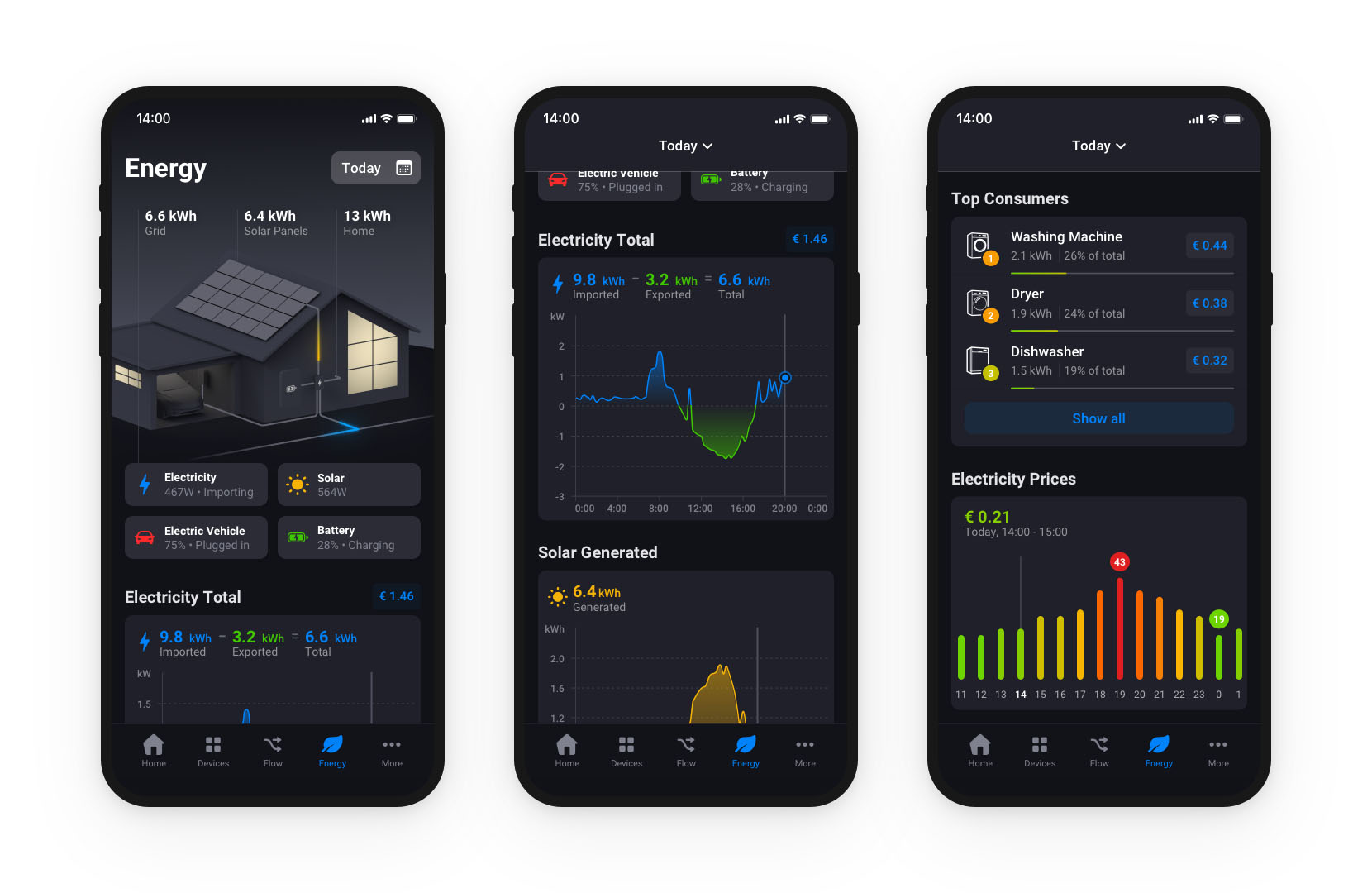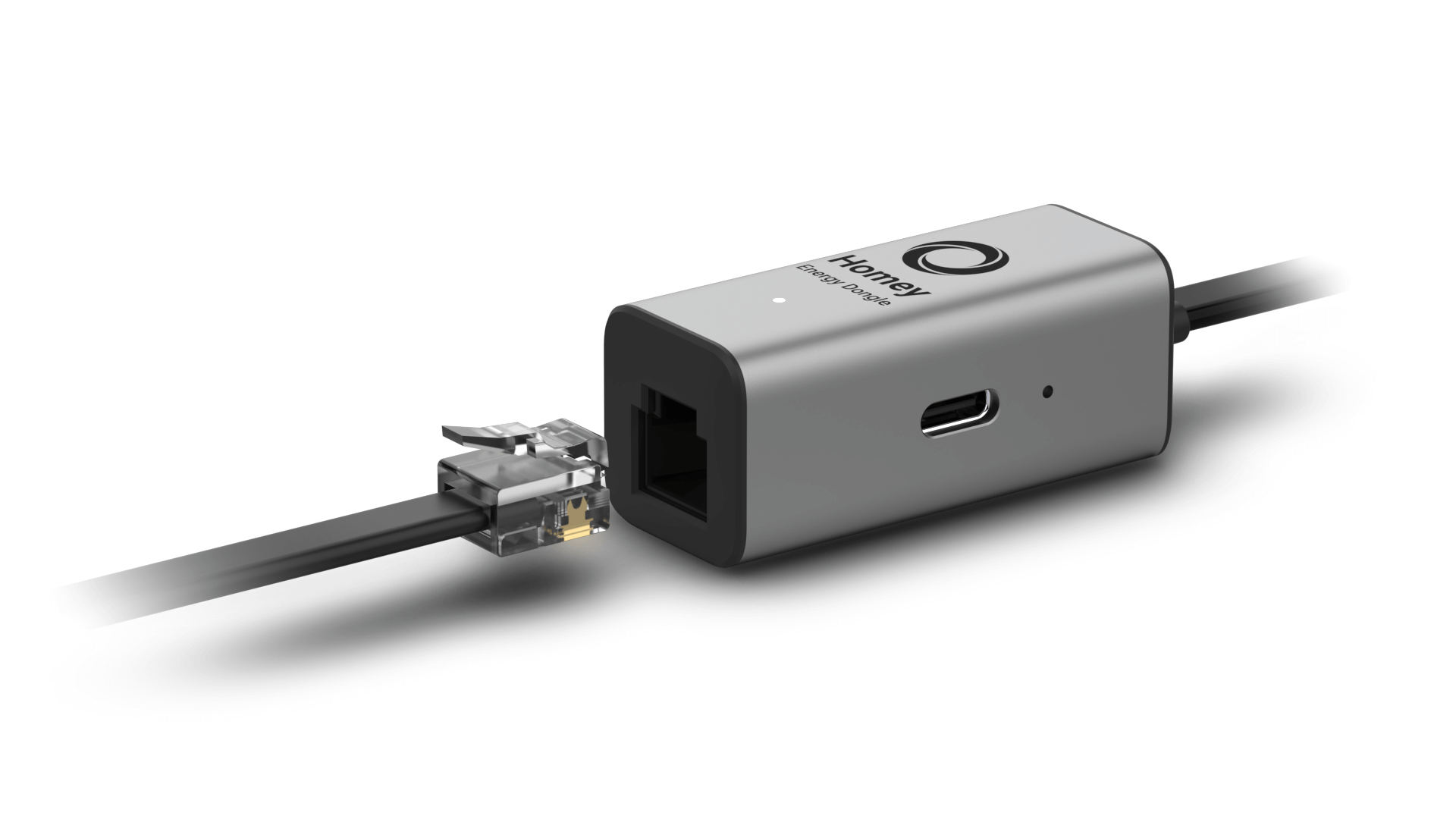
What Are P1 Smart Energy Meters?
Smart Energy Meters are devices designed to measure home energy consumption in real time. But how do they differ from traditional meters? Where are they commonly used? What is P1, exactly? And, since they’re smart, how can we integrate them with smart home systems or help optimize energy usage from renewable energy sources?
Discover how P1 meters work and how P1 readers, like the Homey Energy Dongle, can help you see, reduce, and plan your energy consumption. Interested to see smart home options for Smart Meters? Check out the Best Smart Energy Meters.
P1 Smart Meters at a Glance
- Track real-time energy consumption
- Monitor electricity, gas, and water usage
- Compatible with Renewable Energy Sources
- Compatible with home energy storage systems (ESS)
- Support for dynamic tariff providers
- Enable automation through smart home platforms
- P1 port compatible with real-time readers—like the Homey Energy Dongle
What Are P1 Smart Meters?
P1 Smart Meters are digital utility meters designed to monitor home electricity usage, including delivery or solar energy sent back to the grid. They can also integrate with gas and water meters for comprehensive utility monitoring.
Unlike traditional meters, which record cumulative energy usage and require manual reading, Smart Meters provide real-time data accessible remotely. They transmit this information automatically to connected devices via the P1 port.
What Is the P1 Port on Smart Meters?
The P1 port is a standardized communication interface found on Smart Meters. It allows users to retrieve real-time usage data by connecting a compatible P1 reader, like the Homey Energy Dongle, and integrating it with smart energy management platforms, like Homey. P1 Smart Meters are used in multiple countries.

Countries currently using P1 Smart Meters:
- The Netherlands
- Belgium
- Luxembourg
Countries currently adopting P1 Smart Meters:
- Denmark
- Germany
- Sweden
A compatible reader connected to the P1 port allows users to visualize statistics, track trends, and automate cost-saving routines. This enables more efficient home energy management, which ultimately saves you money.
How Do Smart Meters Work?
Smart Meters collect real-time electricity, gas, and water consumption data using built-in sensors and communication modules. Data is aggregated, consolidated, and exported through the P1 port in a standardized format, integrating with compatible readers.
Smart Meters can process incoming data from energy storage systems, solar panels, and inverters. This capability enables them to track both energy drawn from the grid and generated or exported back.
Advantages of Using Smart Meters
Smart Meters with a P1 port offer significant advantages over traditional utility meters, transforming how energy consumption is monitored and managed. These benefits include:
Real-time Energy Monitoring
Traditional meters require manual readings and often provide delayed consumption data, visible only in monthly bills. In contrast, P1-enabled Smart Meters deliver real-time insights into electricity, gas, and water usage. This immediate feedback allows users to make timely, informed decisions about their energy consumption.
Optimized Energy Usage and Cost Savings
P1 Smart Meters offer detailed, real-time data so users can identify energy-intensive appliances and adjust their usage patterns accordingly. This unlocks savings opportunities that traditional meters cannot provide.
Compatibility with Renewable Energy Systems and ESS
Designed to handle dynamic energy flows, P1 Smart Meters support renewable energy sources like solar panels and energy storage systems (ESS). They track energy exported back to the grid and can adapt consumption accordingly.
Integration with Dynamic Tariff Systems
P1-enabled meters can integrate with utility providers offering dynamic pricing, enabling users to benefit from lower electricity rates during off-peak hours. For instance, Tibber, a digital energy provider, uses real-time market prices to offer dynamic electricity tariffs. During cheaper rate periods, users can optimize activities like EV charging or running energy-demanding appliances.
Future-Proofing with DSMR Standards
With the DSMR standard defining P1 port functionality, these meters ensure compatibility with current and future energy monitoring technologies. This future-proof design guarantees long-term usability and adaptability to evolving smart home and energy management systems.
Which Countries Use P1 Smart Meters?
P1 Smart Meters, featuring the standardized P1 port, are primarily adopted in European countries where the DSMR (Dutch Smart Meter Requirements) standard is prevalent. Their adoption varies depending on national policies, utility company initiatives, and consumer demand. Below is an overview of the key countries utilizing P1 Smart Meters and their adoption rates:
The Netherlands
The Netherlands has emerged as a leader in adopting P1 Smart Meters, with nearly all households equipped with DSMR-compliant meters as of 2023. Major utility providers like Liander and Stedin, in collaboration with manufacturers such as Landis+Gyr and Iskraemeco, have ensured nearly universal access to real-time energy monitoring.
Belgium
The adoption of P1 Smart Meters has grown steadily in Belgium, especially in the Flemish region. Fluvius, the leading utility operator, has replaced traditional meters with DSMR-compliant models from manufacturers like Sagemcom and Landis+Gyr. By 2024, 80% of households are expected to have access to these advanced meters.
Luxembourg
Luxembourg has adopted the DSMR standard for its Smart Meters, which include the P1 port, though its adoption rate is slightly lower than its neighbors. Creos, the primary network operator, has led the deployment of P1-compatible meters, focusing on enhancing smart grid capabilities.
Other European Countries
In countries like Germany, Sweden, and Denmark, P1-like capabilities are emerging, with utilities testing or deploying meters that allow real-time energy monitoring. Nordic countries like Sweden and Denmark have seen higher adoption rates due to regulatory mandates, while Finland has progressively adopted meters supported by forward-thinking energy-saving policies.
Integration of P1 Smart Meters with Homey
A good energy monitoring solution is essential for saving energy and reducing costs, but a reliable controller is necessary to truly take advantage of the data provided. This is where Homey comes in—the world’s most advanced smart home hub.
Homey supports a variety of smart energy meters, including optical pulse meters like the Frient Electricity Meter and 3-phase clamp meters like the Shelly Pro 3EM. However, the most advanced features and functionality are unlocked with P1-compatible Smart Meters, such as the Homey Energy Dongle.

Maximizing Solar Panel Utilization
When integrated with a P1-compatible Smart Meter, Homey can monitor the energy generated by your solar panels in real time. During periods of excess generation, Homey can automatically trigger energy-intensive appliances, such as heat pumps or boilers, to maximize your self-produced renewable energy. This reduces reliance on the grid and maximizes your solar setup’s financial and environmental benefits.
Optimizing Electric Vehicle Charging
By combining data from the smart meter and your EV charger, Homey can ensure your electric vehicle charges during off-peak hours or when surplus solar energy is available. For example, Homey can prioritize charging your EV during sunny periods when solar panels produce excess electricity or schedule charging at night when electricity tariffs are lower, significantly reducing charging costs.
Efficient Energy Storage Management
Homey can work with energy storage solutions by monitoring the energy flow from your battery system via the smart meter. It can intelligently decide when to charge or discharge the battery based on solar energy availability or electricity pricing. For instance, Homey can ensure your battery is fully charged during high solar output. During peak electricity rates, it can switch to battery power to reduce grid dependency and save on energy costs.
Start Saving Energy
With Homey and the Homey Energy Dongle connected to your P1 smart meter, you can take complete control of your home energy consumption. Click here to learn more.








